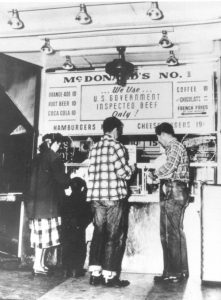
If you were on a budget and taking the kids out for a quick bite to eat after a long day at work, which fast-food restaurant would you choose?
- Restaurant A serves a 2.8-ounce hamburger (no cheese) with a 2.4-ounce bag of fries, and a 6.5-fluid-ounce regular cola
- Restaurant B serves a 4.3-ounce burger with cheese, a 7-ounce carton of fries, and a 16-fluid-ounce diet cola
Restaurant A was the common take-out meal in 1954. Total caloric intake was 491 calories (including the cola), and no neurotoxins or carcinogens were in the drink.
Restaurant B was a typical carryout in 2004. Super-size it for a total of 1,000 calories (cola included), and people today justify larger portions by drinking “diet.”
“Super-sizing is a public health issue of the highest priority,” said Harvard University’s Dr. George Blackburn, a Professor of Nutrition and Surgery.
Super-sizing has become controversial these days.
As part of a “healthy lifestyle initiative”, in 2004 McDonalds®, the corporation that popularized the “super-sized” concept, announced it would be discontinuing its 42-ounce “super-sized” soda, as well as its 17-ounce “super-sized” order of fries at all 13,000 U.S. stores.

The Size Of Your Meals
So, the average consumer today eats almost twice the portions of food as from 20 years ago.
The marketing of artificial sweeteners has been a huge contributing factor to changing the way people look at their meals.
Jean Weininger from the San Francisco Chronicle writes:
Studies have shown that people who use artificial sweeteners don’t necessarily reduce their consumption of sugar — or their total calorie intake. Having a diet soda makes it okay to eat a double cheeseburger and a chocolate mousse pie.”
She makes a great point.
Instead of loading up on diet products, try cutting your portions of real food in half. Dr. Kristine Clark, RD, Director of Sports Nutrition, Pennsylvania State University suggests:
Eat what you want, but eat half. Leave food on your plate—there is no such thing as a “Clean Plate Club!”
She emphasizes more physical activity on a daily basis, along with modifying the portions of your foods and beverages.
This should break the cycle of weight gain,” she states.
Super-Size It
A single 20-ounce bottle of soda is actually 2 1/2 servings. In America, muffins are the size of small cakes.
Care for a large order of French fries? It’s just a few cents more to super-size that order.
That’s 1/3 of the total calories you should eat in one day! But ask yourself – do people resist the fries? No, not usually.
They order a large diet cola to justify the difference.
According to a new study by the Centers for Disease Control and Prevention, women are eating 300 more calories a day and men 168 more calories than 20 years ago.
As any nutritionist will tell you, all it takes is 100 extra calories a day to gain ten pounds a year. To work off those 100 calories, you must walk 25 minutes every day.
In Sting’s first book, “Broken Music,” he writes about the first time he came to New York City. On a limited budget, he ordered a salad thinking this would be mere rabbit food, yet it was all he could afford. When the salad arrived at his table he was amazed at how large it was, and commented in his book that one of the first impressions he had about America was how much food Americans ate, and how much larger the portions were compared to Europeans’.

Many experts feel Americans overeat because much of the food that makes up the American diet is inexpensive, dense with the taste of “fat” calories, and highly processed; so again, the food isn’t satisfying to your body’s needs, and you eat more to try to feel full.
And never forget that diet sweeteners are highly addictive; one small serving is never enough.
Ways To Control Your Portions
Accurately estimating food portions can be difficult if you are dieting or hungry. This chart makes measuring simple and helps you estimate your portions correctly.
Food Portions:

* One teaspoon (5 ml)
— about the size of the top half of your thumb
* One ounce (28 g)
— approximately a one-inch cube of cheese
– volume of four stacked dice
– slice of cheese is about the size of a 3 1/2-inch computer disk
– chunk of cheese is about as thick as two dominoes
– one handful (your palm) of nuts
* Two ounces (57 g)
– one small chicken leg or thigh
– 1/2 cup of cottage cheese or tuna
* Three ounces (85 g)
– serving of meat is about the size of a deck of playing cards
– 1/2 of whole chicken breast
– one medium pork chop
– one small hamburger
– unbreaded fish fillet
* 1/2 cup (118 ml)
– fruit or vegetables can fit in the palm of your hand
– about the volume of a tennis ball
* 1 cup (236 ml)
– about the size of a woman’s fist
– breakfast cereal goes halfway up the side of a standard cereal bowl
– broccoli is about the size of a light bulb
* One medium apple = a tennis ball
Now when you eat, think of a deck of cards, light bulbs and tennis balls!
_____________
If you want to learn more about healthy lifestyles, contact me at janethull.com. Remember that you are never alone when you are looking for good health!
Gain access to all of my online programs, ongoing support, monthly Q&A, and more by joining my Private Inner Circle Membership Program. I look forward to supporting you on your journey to alternative health and wellness.
_____________
Disclaimer: This article is for informational purposes only, and is educational in nature. The FDA may not have evaluated some of the statements. This article is not intended to diagnose, treat, cure, or prevent any disease. Please discuss with your own, qualified health care provider before adding supplements or making any changes to your dietary program.
Before taking vitamins, consult your doctor; pre-existing medical conditions or medications you are taking can affect how your body responds to multivitamins.
You have our permission to reprint this article if you attribute us with a live back-link to this article and the youtube links. https://janethull.com/